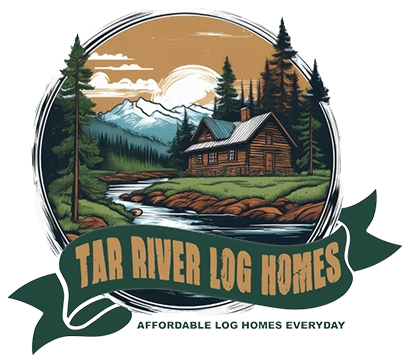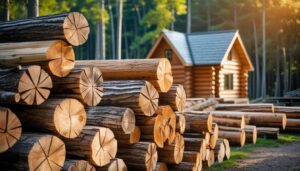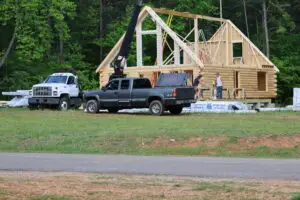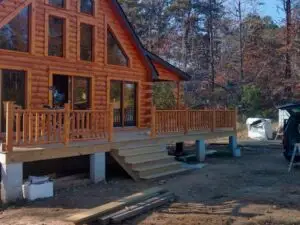Choosing the best wood for a log cabin isn’t just about looks—it’s about how long your home will last. Durability, cost, and insulation all change depending on the species and how the logs are treated.
Families often balance budget with long-term upkeep. Pine, cedar, and fir are favorites because they blend strength with affordability. Each wood brings different care needs and benefits to the table.
At Tar River Log Homes, Eastern White Pine is a go-to: kiln-dried, reliable, and priced fairly. Knowing what makes a wood type practical helps you avoid costly mistakes down the road.
This guide covers top species, insulation values, costs, and sustainability, so you can build a cabin that’s strong, efficient, and affordable.
Understanding Wood Types for Log Cabins
Your choice of wood shapes your cabin’s strength, looks, and lifespan. Think about the type of wood, how dry it is before you build, and its grain and density. All these details add up to a home that feels solid and inviting.
Softwoods vs. Hardwoods
Softwoods like pine, cedar, and spruce are the go-to for log cabins. They’re lighter, easier to handle, and usually easier on the budget. Pine is a favorite—strong, affordable, and it insulates well to keep things warm inside.
Hardwoods, like oak or hickory, are tougher and last longer, but they’re pricier and a pain to cut. They resist dents and wear, sure, but most folks stick with softwoods since they’re easier to work with and cover most needs. If you’re watching your budget and want something practical, softwoods are probably your best bet.
Seasoned vs. Green Wood
Seasoned wood gets dried out before building. Less moisture means less shrinking and fewer headaches with cracks and gaps later. Using seasoned wood helps your cabin stay tight and sturdy.
Green wood is freshly cut and still loaded with water. It’s cheaper, but it’ll shrink and settle a lot after you build, which can mean warping or leaks. Most pros prefer seasoned wood—it just saves you trouble in the long run.
Moisture Management and Proper Drying
Moisture content impacts stability. The Department of Energy notes kiln-dried logs reduce shrinkage and energy loss compared to green logs. Proper drying prevents mold and warping, helping walls stay tight through seasonal shifts.
Grain and Density Considerations
Grain matters for both strength and looks. Straight-grain wood stacks easier and seals up tighter. Twisted or knotty grain gives a rustic vibe, but you might get more drafts sneaking in.
Denser wood is stronger and shrugs off weather better, but it’s heavier and tougher to work with. It’s a balancing act. For most cabins, wood with a straight grain and medium density makes the build easier and keeps things strong.
You want something that fits your budget but can also handle the seasons and everyday use. That’s how your log cabin stays warm and solid for years to come.
Most Popular Wood Species for Log Cabins
Picking the right wood comes down to durability, cost, and looks. Some woods shrug off weather, others ask for less maintenance. You’re aiming for something that fits your lifestyle without skimping on quality.
Pine
Pine is everywhere in the log cabin world. It’s affordable, easy to work with, and lighter than most, so building goes smoother. Pine also takes stains and finishes nicely, so you can customize your cabin however you like.
It’s a softer wood, so yeah, it might dent or scratch more easily. But seal it well, and pine will resist decay and bugs for years. Pine logs are kiln-dried to cut down on cracking and shrinking, giving you a solid cabin base without breaking the bank.
Cedar
Cedar’s got a reputation for resisting rot and insects naturally. You won’t need as much chemical treatment, and it handles damp or unpredictable weather like a champ. Its deep color and that classic cedar smell are a bonus if you’re after a timeless look.
It’s light but tougher than pine—good for both walls and accents. You’ll pay more upfront, but low maintenance means less fuss (and less money spent) over the years.
If you want warmth in tone and don’t want to fuss with upkeep, cedar’s a solid pick. Especially if you’re in a rainy or humid spot.
Douglas Fir
Douglas Fir stands out for its strength and toughness. It’s harder than pine or cedar, so it handles wind and heavy snow well. The straight grain makes milling predictable, which is great if you want tight, clean lines.
It usually costs a bit more than pine but less than cedar. The color is light with hints of red or yellow, which gives your cabin a fresh, bright feel. If you’re after a robust, long-lasting log home without paying top dollar, Douglas Fir is worth a look.
Evaluating Durability and Longevity
When you’re picking wood for your log cabin, you’ve got to think about how it’ll hold up over the years. Will it fight off rot? Handle tough weather? Will you be stuck doing constant repairs?
Resistance to Decay
Wood rots when it gets wet and stays that way. Some species handle it better—cedar and cypress have natural oils that fight rot. Pine, especially Eastern White Pine, needs a bit more TLC or treatment to hold up.
If you’re in a rainy or humid area, lean toward wood with good decay resistance, or be ready to treat it regularly. Wood that sits near the ground or gets wet often will rot fast if you don’t stay on top of it. Outdoor-rated wood helps your home stay strong.
Weathering Qualities
Sun, wind, rain, and snow all take a toll. Some woods—cedar and Douglas fir, for example—hold their shape and don’t warp or crack as much. They’ll stay put even as the temperature swings.
Eastern White Pine can work fine too, but you’ll want to protect it with good coatings. If wood weathers poorly, it’ll crack, split, or shrink, letting in drafts or bugs. Pick something that holds up in your local climate.
Maintenance Demands
Every wood needs some care, but some types make your life easier. Cedar’s natural oils mean less cleaning and fewer treatments. Pine might need annual staining or sealing to keep it protected.
Plan to check your logs once a year, especially if you live where it’s wet or sunny. Clean them up, reapply finishes, and you’ll keep moisture and decay at bay. Quality, kiln-dried logs matched to your climate save time and reduce maintenance costs.
| Factor | Best Wood Types | Care Needed |
| Resistance to Decay | Cedar, Cypress | Low to moderate |
| Weathering Qualities | Cedar, Douglas Fir | Moderate protection needed |
| Maintenance Demands | Oiled or treated softwoods | Regular sealing or staining |
Insulation and Energy Efficiency Factors
You should know how well your log cabin will keep heat in and cold out. Different woods insulate differently, and that can mean real savings on energy bills—not to mention comfort.
Thermal Performance
Wood’s natural insulation is one of its best features. Denser woods generally slow down heat transfer better, so your place stays warmer in winter and cooler in summer. Softwoods with tight grain trap air pockets, adding even more insulation.
Don’t forget about moisture—drier wood holds heat better because water helps heat escape. Thick logs—think 8 inches or more—can really cut heat loss. Seal up the spaces between logs well, and you’ll keep drafts out.
R-Values by Species
R-value measures how well a material resists heat flow. Higher is better.
| Wood Species | Approximate R-Value per Inch | Notes |
| Eastern White Pine | 1.3 | Lightweight, good insulator |
| Douglas Fir | 1.2 | Strong, moderately insulating |
| Cedar | 1.5 | Naturally resistant to decay |
| Spruce | 1.25 | Common, balanced insulation |
Eastern White Pine edges out Douglas Fir a bit, and cedar does even better, plus it’s tough against weather. If you want solid insulation at a decent price, Eastern White Pine is a smart pick.
Cost Considerations for Different Woods
Your wood choice affects what you’ll pay now and what you’ll spend later. Some woods are pricier because they last longer or are harder to source. It helps to know what’s driving those costs.
Upfront Costs
Some woods are cheaper upfront but might cost you more in the long run. Eastern White Pine is often the most affordable at the start. It’s easy to work with, which can cut labor costs, too.
Hardwoods like cedar or oak? They’ll cost more right away. They’re denser and need more processing, but you get better natural resistance to bugs and weather.
Availability in Regions
Where you live matters. If a wood grows nearby, it’ll be cheaper. Shipping from far away adds up fast.
Eastern White Pine is common in the eastern U.S., so it’s usually cheaper there. Lighter pine also saves on transport.
If you want cedar but you’re nowhere near a cedar forest, expect to pay more. Sometimes logs travel thousands of miles, and you’ll see that in the price.
Long-Term Value
Cheaper woods can mean more repairs and treatments over time. Softer woods might need more upkeep.
Hardwoods are tougher and naturally resist rot and bugs, so you’ll spend less on maintenance. Your cabin stays safe, and you save money in the long run.
Environmental and Sustainability Issues
Picking wood for your log cabin isn’t just about you—it’s about the planet, too. Where your wood comes from and how it’s harvested matters for the environment.
Forest Stewardship Certifications
Look for wood certified by groups like FSC (Forest Stewardship Council) or SFI (Sustainable Forestry Initiative). These mean the wood comes from forests managed with care for wildlife, water, and soil. Certified forests require replanting after harvest, so future generations have trees, too.
Using certified wood helps avoid illegal logging and supports healthy forests. When you choose certified, you’re picking materials that meet real environmental standards—and that feels good.
Impact of Harvesting Methods
How trees are cut affects everything. Selective logging takes only some trees, keeping the forest mostly intact and habitats safe. Clear-cutting wipes out everything in an area, which can really mess up ecosystems and cause erosion.
Sustainable harvesting means timing things right—cutting trees at the right age and season keeps forests healthy. Don’t be shy about asking your supplier how they do things. Focus on wood from carefully managed sources, balancing what’s needed for building with what’s good for nature.
Design and Aesthetic Impact
Your wood choice shapes how your cabin looks and feels. Each species has its own grain patterns and changes color as it ages. Those details can make your cabin feel uniquely yours—or just right for your taste.
Visual Appeal of Grain Patterns
Grain patterns really shape a wood’s personality, so picking the right one matters more than you might think. Pine has these straight, even grains that give off a clean, rustic vibe. It’s simple, not too flashy.
Cedar’s a bit wilder, with swirling and knotty patterns that catch your eye. There’s something cozy about it, almost like the wood’s got a story.
Hardwoods like oak? Those show off tight, intricate grains, but they’ll hit your wallet harder. It’s worth thinking about whether you want the grain to stand out or just blend in with your cabin’s look.
Quick tips:
- Straight grain = simple, classic
- Swirling grain = warm, rustic feel
- Tight grain = detailed, traditional look
Color Changes Over Time
Wood doesn’t stay the same color forever. Sunlight and age work their magic. Pine starts off a pale cream, then slowly shifts to a warm yellow or amber as the years go by.
Cedar’s another story—it’ll fade to a silvery gray if you leave it outside untreated. Some folks love that weathered, old-cabin look, but you can hold onto the original color with stains or sealants if you want.
If you’d rather your cabin keep its original shade, pick a wood that holds color or be ready to put in a little maintenance every so often.
Wood color behavior:
| Wood Type | Initial Color | Aging Effect |
| Pine | Light cream | Darkens to amber/yellow |
| Cedar | Reddish-brown | Fades to silver-gray |
| Oak | Light to medium | Slight darkening over time |
Popular Regional Choices in North America
Where you live in North America really steers your wood options. Different regions have their go-to woods for log cabins.
Up in the Northeast, Eastern White Pine is the favorite. It’s light, easy to use, and insulates well. Plus, it’s affordable and tough enough for cabin walls.
Out in the Pacific Northwest, folks lean toward Douglas Fir. It’s sturdy and shrugs off decay—great if you’re dealing with lots of rain and snow.
Down South, Cypress and Eastern Red Cedar get the nod. They naturally resist bugs and rot, so your cabin holds up in humid weather.
Here’s a quick look at these woods:
| Region | Common Wood | Benefits |
| Northeast | Eastern White Pine | Lightweight, good insulation |
| Pacific Northwest | Douglas Fir | Strong, decay-resistant |
| South | Cypress, Red Cedar | Insect and rot-resistant |
Eastern White Pine and other species are widely available at fair prices through regional suppliers. So you get quality wood without the sticker shock. You pick the style, and they’ll help you sort out the right materials for your climate.
Tips for Choosing the Right Wood for Your Log Cabin
When you’re picking wood for your cabin, durability should come first. You want something that stands up to weather and bugs. Cedar and pine are solid bets—they last and don’t give in easily to decay.
Think about the look, too. Some woods just have a charm to them. Eastern white pine’s a classic: nice color, easy to work with, and it just looks good.
Make sure the wood’s properly dried. Kiln-dried logs have less moisture, so you’ll see fewer cracks and less shrinking. That means your cabin stays tight and looks sharp over time.
Cost matters, of course. Some woods are affordable and still tough as nails. A trusted company offers high-quality materials at wholesale prices, so you don’t have to compromise.
Don’t forget to match your logs to your building plan. Your design might call for certain sizes or types. You choose the style, they’ll handle the rest—keeps things straightforward.
| Wood Type | Durability | Cost | Appearance |
| Eastern White Pine | Good | Affordable | Light, smooth |
| Cedar | Very good | Mid-range | Rich color, knots |
| Spruce | Fair | Low | Pale, soft texture |
Balancing these factors helps you land on the right wood for your budget and style. If you’re building a home for hardworking folks, it ought to last—without costing a fortune.
Choosing The Best Wood For Your Log Cabin
Your cabin’s strength and comfort depend on the wood you pick. Pine brings affordability and ease, cedar adds natural decay resistance, and fir balances strength with cost. If sustainability matters, look for certified logs.
Studies confirm kiln-dried logs outperform green wood for durability and energy savings. At Tar River Log Homes, Eastern White Pine offers the right mix of value, durability, and appearance for your build.
Ready to start? Request a quote for kiln-dried Eastern White Pine today.
Frequently Asked Questions
Picking the right wood changes how tough your cabin is, how much you’ll need to fuss with maintenance, and how long it’ll stand. Each wood has its pros, depending on what you need and what you’re willing to spend.
What type of wood offers the best durability for building a log cabin?
Cedar, oak, and cypress are all known for sticking around. Cedar’s a standout—it shrugs off rot and insects better than most.
How does the choice of wood affect the maintenance needs of a log cabin?
Pine and other softwoods need more sealing and upkeep to avoid damage. Hardwoods need less attention but usually cost more up front.
What are the advantages of using cedar logs for cabin construction?
Cedar’s light, strong, and naturally keeps bugs and rot at bay. It holds its shape, so your cabin stays solid year after year.
Can you compare pine and oak for their suitability in log home building?
Pine’s easier to handle and saves you money, but it doesn’t last as long outside. Oak’s tough and lasts, but it’s heavier and pricier.
Are there specific types of logs that are recommended for building a traditional log home?
Eastern White Pine and cedar are both popular picks. They’re affordable, easy to work with, and look right at home in a classic cabin.
What should I look for when choosing wood for my log cabin to ensure longevity?
Pick wood that’s straight, dry, and doesn’t have big knots or cracks. Kiln-dried wood? Absolutely—it’s way less likely to warp or attract bugs down the road.
Tar River Log Homes leans into quality, offering top-notch logs like Eastern White Pine. You get solid materials at decent prices, so you won’t have to give up durability just to save a few bucks.





